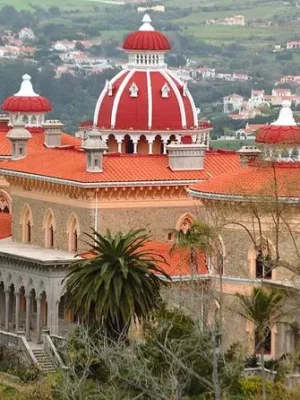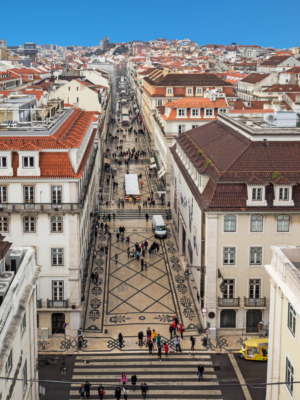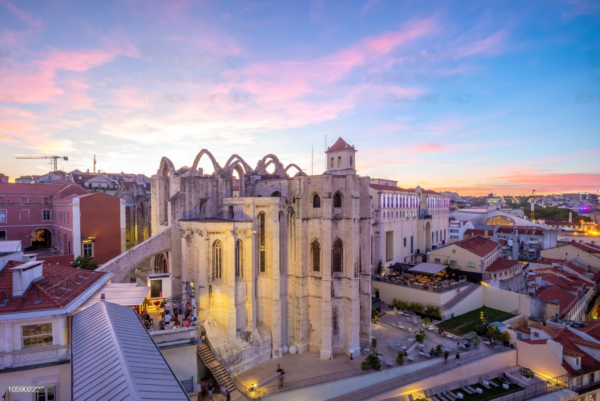Translation: Recommendations for restaurants near Pena Palace with the highest ratings on Tripadvisor.
Antikuario Cafe (263 reviews)
BaixaMar Lisboa – Mariscos e Petiscos** (876 reviews)
Chão de Pedra (775 reviews) ¹




Touch each icon to get the information.
How to get there
- “Recommendation: Use the metro for faster and easier transportation in the city. Save time and navigate with ease by choosing the metro as your preferred mode of transportation“.
How to get to the Convento do Carmo by bus from any point in Lisbon:
To reach the Convento do Carmo by bus, you can follow the following directions:
If you are in Praça do Comércio, Rua da Conceição, or Rua da Madalena, you can take bus number 28 towards Campo Ourique. Get off at the stop Largo do Calhariz – Calçada da Estrela.
Click on the following link to view the schedule and route of bus 28E: [Link].
If you are in Praça da Figueira, Rua do Crucifixo, or Terreiro do Paço, you can take bus number 711 towards Parque das Nações. Get off at the stop Avenida 24 de Julho – Rua do Cais.
Click on the following link to view the schedule and route of bus 711: [Link].
From these stops, you can follow the following directions to reach the Convento do Carmo:
From the stop Largo do Calhariz – Calçada da Estrela, walk towards Rua da Estrela and continue until Rua Saraiva de Carvalho. Turn right onto Rua de São Bento and continue straight until you reach the Convento do Carmo.
From the stop Avenida 24 de Julho – Rua do Cais, walk towards Avenida 24 de Julho and continue until Largo de Santos. Turn right onto Avenida Infante Santo and continue straight until you reach Avenida da Índia.
Turn right onto Rua da Junqueira and continue until you reach the Convento do Carmo.
Please note that bus numbers and stops mentioned are subject to change. We recommend checking updated schedules and routes before your trip.
Here are the complete instructions on how to reach the Convento do Carmo using the metro:
Scenario 1: If you are on the Red Line (Linha Vermelha) –
Head in the direction of São Sebastião.
Transfer at Alameda station to the Green Line (Linha Verde).
Continue on the Green Line in the direction of Cais do Sodré.
Get off at Baixa-Chiado station.
Exit the metro station and follow the signs for Rua Garrett.
Walk along Rua Garrett until you reach the Largo do Carmo square.
The Convento do Carmo will be on your left.
Scenario 2: If you are on the Blue Line (Linha Azul) –
Head in the direction of Santa Apolónia.
Transfer at Baixa-Chiado station to the Green Line (Linha Verde).
Continue on the Green Line in the direction of Cais do Sodré.
Get off at Baixa-Chiado station.
Exit the metro station and follow the signs for Rua Garrett.
Walk along Rua Garrett until you reach the Largo do Carmo square.
The Convento do Carmo will be on your left.
Scenario 3: If you are on the Yellow Line (Linha Amarela) –
Head in the direction of Rato.
Transfer at Marquês de Pombal station to the Blue Line (Linha Azul).
Head in the direction of Santa Apolónia.
Transfer at Baixa-Chiado station to the Green Line (Linha Verde).
Continue on the Green Line in the direction of Cais do Sodré.
Get off at Baixa-Chiado station.
Exit the metro station and follow the signs for Rua Garrett.
Walk along Rua Garrett until you reach the Largo do Carmo square.
The Convento do Carmo will be on your left.

Above in the photo gallery you will find the map in real size.
From any point on the line heading to Santa Apolónia:
Take the train towards Santa Apolónia.
Get off at Santa Apolónia station.
Inside Santa Apolónia station, look for the entrance to the metro (blue line).
Take the metro towards Baixa-Chiado.
Get off at Baixa-Chiado station.
Follow the previously mentioned directions to reach the Convento do Carmo from Baixa-Chiado station.
From any point on the Cascais line:
Take the train on the Cascais line heading to Cais do Sodré.
Get off at Cais do Sodré station.
From Cais do Sodré station, take the metro (green line) towards Baixa-Chiado.
Get off at Baixa-Chiado station.
Follow the previously mentioned directions to reach the Convento do Carmo from Baixa-Chiado station.
From any point on the Sintra line:
Take the train on the Sintra line heading to Rossio.
Get off at Rossio station.
Follow the previously mentioned directions to reach the Convento do Carmo from Rossio station.
Remember, in all cases, once you arrive at the respective station, you should follow the previously mentioned directions to reach the Convento do Carmo.
I hope these updated instructions are helpful for reaching the Convento do Carmo from different train stations.
Explore the beauty of Convento do Carmo with ease!
Simply click on the ‘Take me to Convento do Carmo’ button below, and it will automatically open the Google Maps application on your mobile device or computer.
The starting location will already be configured, so you just need to follow the step-by-step directions provided by Google Maps. Enjoy a hassle-free journey as you’re guided through the best routes to reach this historic convent in Lisbon. Exploring the city couldn’t be easier with the help of Google Maps!
Please make sure to add the appropriate button on your website with the necessary functionality to open the Google Maps application with the preconfigured location.
Once you arrive at the site, listen to a brief explanation of the history of the place.
- Audio in English
- Audio en français
- Audio en Español
- Audio auf Deutsch





Choose Your Language.
- Reading in English
- Lire en Français
- Lectura en Español
- Lesen auf Deutsch
The Convento do Carmo, also known as the Convent of Nossa Senhora do Carmo, is an ancient convent located in the heart of Lisbon, Portugal. Its construction began in 1389 and was founded by the Order of Carmel, a Catholic religious order.
The convent was originally established as a place of prayer and spiritual retreat for the Carmelite friars. For centuries, it was an important religious and cultural center in Lisbon. However, the history of the convent took a dramatic turn in 1755.
On November 1st of that year, Lisbon was shaken by one of the most devastating earthquakes in European history. The Lisbon earthquake destroyed much of the city, including the Convento do Carmo. The damage was so extensive that the building was left in ruins.
Despite the destruction, the convent was never completely abandoned. Some repairs were carried out in the least damaged areas, and it was converted into a parish church. During the 19th century, further restoration work was done, and a wooden roof was built over the ruins of the main nave.
Today, the Convento do Carmo houses the Carmo Archaeological Museum. This museum exhibits an impressive collection of historical and archaeological artifacts, spanning from prehistory to the medieval period. Among the highlights are Roman sarcophagi, Gothic sculptures, and a collection of Portuguese tiles.
The Convento do Carmo is also known for its Gothic architecture. Although much of the original building was destroyed, the ruins still retain an impressive beauty and grandeur. The tall columns, pointed arches, and broken stained glass windows evoke the past greatness of the convent and serve as a reminder of the tragedy of the earthquake.
In addition to its historical and cultural significance, the Convento do Carmo also offers spectacular views of the city of Lisbon. From the ruins, one can enjoy incredible panoramas that encompass the old town, the Tagus River, and the Chiado neighborhood.
In summary, the Convento do Carmo is a place full of history and beauty. From its foundation in the 14th century to the devastating earthquake of 1755, and its subsequent restoration and transformation into a museum, this convent has witnessed the ups and downs of Lisbon’s history. I hope you have enjoyed this immersion in the history of the Convento do Carmo and make the most of your visit to this fascinating place.
Le Convento do Carmo, également connu sous le nom de Convento de Nossa Senhora do Carmo, est un ancien couvent situé au cœur de Lisbonne, au Portugal. Sa construction a débuté en 1389 et a été fondée par l’Ordre du Carmel, un ordre religieux catholique.
Le couvent a été initialement établi comme un lieu de prière et de retraite spirituelle pour les frères carmes. Pendant des siècles, il a été un centre religieux et culturel important à Lisbonne. Cependant, l’histoire du couvent a pris un tournant dramatique en 1755.
Le 1er novembre de cette année-là, Lisbonne a été secouée par l’un des tremblements de terre les plus dévastateurs de l’histoire européenne. Le tremblement de terre de Lisbonne a détruit une grande partie de la ville, y compris le Convento do Carmo. Les dégâts étaient si importants que le bâtiment a été laissé en ruines.
Malgré la destruction, le couvent n’a jamais été complètement abandonné. Des réparations ont été effectuées dans les zones moins endommagées et il a été transformé en église paroissiale. Au cours du XIXe siècle, d’autres travaux de restauration ont été réalisés et un toit en bois a été construit sur les ruines de la nef principale.
Aujourd’hui, le Convento do Carmo abrite le Musée archéologique du Carmo. Ce musée présente une impressionnante collection d’artefacts historiques et archéologiques, couvrant de la préhistoire à l’époque médiévale. Parmi les pièces les plus remarquables, on trouve des sarcophages romains, des sculptures gothiques et une collection de carreaux portugais.
Le Convento do Carmo est également connu pour son architecture gothique. Bien que la majeure partie du bâtiment d’origine ait été détruite, les ruines conservent encore une beauté et une majestuosité impressionnantes. Les hautes colonnes, les arcs brisés et les vitraux évoquent la grandeur passée du couvent et rappellent la tragédie du tremblement de terre.
En plus de son importance historique et culturelle, le Convento do Carmo offre également une vue spectaculaire sur la ville de Lisbonne. Depuis les ruines, on peut profiter de panoramas incroyables qui englobent la vieille ville, le fleuve Tage et le quartier de Chiado.
En résumé, le Convento do Carmo est un lieu riche en histoire et en beauté. De sa fondation au XIVe siècle au dévastateur tremblement de terre de 1755, en passant par sa restauration ultérieure et sa transformation en musée, ce couvent a été le témoin des hauts et des bas de l’histoire de Lisbonne. J’espère que vous avez apprécié cette plongée dans l’histoire du Convento do Carmo et que vous profiterez au maximum de votre visite dans ce lieu fascinant.
El Convento do Carmo, también conocido como el Convento de Nossa Senhora do Carmo, es un antiguo convento ubicado en el corazón de Lisboa, Portugal. Su construcción comenzó en 1389 y fue fundado por la Orden del Carmen, una orden religiosa católica.
El convento se estableció originalmente como un lugar de oración y retiro espiritual para los frailes carmelitas. Durante siglos, fue un importante centro religioso y cultural en Lisboa. Sin embargo, la historia del convento dio un giro dramático en 1755.
El 1 de noviembre de ese año, Lisboa fue sacudida por uno de los terremotos más devastadores de la historia europea. El terremoto de Lisboa destruyó gran parte de la ciudad, incluido el Convento do Carmo. Los daños fueron tan extensos que el edificio quedó en ruinas.
A pesar de la destrucción, el convento nunca fue completamente abandonado. Se llevaron a cabo algunas reparaciones en las áreas menos dañadas y se convirtió en una iglesia parroquial. Durante el siglo XIX, se realizaron más trabajos de restauración y se construyó un techo de madera sobre las ruinas de la nave principal.
En la actualidad, el Convento do Carmo alberga el Museo Arqueológico del Carmo. Este museo alberga una impresionante colección de artefactos históricos y arqueológicos, que abarcan desde la prehistoria hasta la época medieval. Entre las piezas más destacadas se encuentran sarcófagos romanos, esculturas góticas y una colección de azulejos portugueses.
El Convento do Carmo también es conocido por su arquitectura gótica. Aunque gran parte del edificio original fue destruido, las ruinas aún conservan una belleza y majestuosidad impresionantes. Las altas columnas, los arcos apuntados y las vidrieras rotas evocan la grandeza pasada del convento y ofrecen un recordatorio de la tragedia del terremoto.
Además de su importancia histórica y cultural, el Convento do Carmo también ofrece unas vistas espectaculares de la ciudad de Lisboa. Desde las ruinas, se puede disfrutar de panorámicas increíbles que abarcan el casco antiguo de la ciudad, el río Tajo y el barrio de Chiado.
En resumen, el Convento do Carmo es un lugar lleno de historia y belleza. Desde su fundación en el siglo XIV hasta el devastador terremoto de 1755, pasando por su posterior restauración y transformación en museo, este convento ha sido testigo de los altibajos de la historia de Lisboa. Espero que hayan disfrutado de esta inmersión en la historia del Convento do Carmo y que aprovechen al máximo su visita a este fascinante lugar.
Das Convento do Carmo, auch bekannt als Convento de Nossa Senhora do Carmo, ist ein altes Kloster im Herzen von Lissabon, Portugal. Der Bau begann im Jahr 1389 und wurde von dem Orden der Karmeliter, einem katholischen Ordensgemeinschaft, gegründet.
Das Kloster wurde ursprünglich als Ort des Gebets und der spirituellen Rückzugsmöglichkeit für die Karmelitermönche etabliert. Über Jahrhunderte hinweg war es ein bedeutendes religiöses und kulturelles Zentrum in Lissabon. Doch die Geschichte des Klosters nahm im Jahr 1755 eine dramatische Wendung.
Am 1. November dieses Jahres wurde Lissabon von einem der verheerendsten Erdbeben in der europäischen Geschichte erschüttert. Das Erdbeben von Lissabon zerstörte weite Teile der Stadt, einschließlich des Convento do Carmo. Die Schäden waren so umfangreich, dass das Gebäude in Ruinen zurückblieb.
Trotz der Zerstörung wurde das Kloster nie vollständig aufgegeben. Es wurden Reparaturen in den weniger beschädigten Bereichen durchgeführt und es wurde zu einer Pfarrkirche umgewandelt. Im 19. Jahrhundert wurden weitere Restaurierungsarbeiten durchgeführt und über den Ruinen des Hauptschiffs wurde ein hölzernes Dach errichtet.
Heute beherbergt das Convento do Carmo das Archäologische Museum von Carmo. Dieses Museum präsentiert eine beeindruckende Sammlung von historischen und archäologischen Artefakten, die von der Vorgeschichte bis ins Mittelalter reichen. Zu den Höhepunkten gehören römische Sarkophage, gotische Skulpturen und eine Sammlung portugiesischer Fliesen.
Das Convento do Carmo ist auch für seine gotische Architektur bekannt. Obwohl ein Großteil des ursprünglichen Gebäudes zerstört wurde, haben die Ruinen immer noch eine beeindruckende Schönheit und Erhabenheit bewahrt. Die hohen Säulen, Spitzbögen und zerbrochenen Buntglasfenster erinnern an die vergangene Pracht des Klosters und sind ein Mahnmal für die Tragödie des Erdbebens.
Neben seiner historischen und kulturellen Bedeutung bietet das Convento do Carmo auch spektakuläre Ausblicke auf die Stadt Lissabon. Von den Ruinen aus kann man unglaubliche Panoramen genießen, die die Altstadt, den Fluss Tejo und das Viertel Chiado umfassen.
Zusammenfassend ist das Convento do Carmo ein Ort voller Geschichte und Schönheit. Von seiner Gründung im 14. Jahrhundert über das verheerende Erdbeben von 1755 bis hin zur späteren Restaurierung und Umwandlung in ein Museum hat dieses Kloster die Höhen und Tiefen der Geschichte von Lissabon miterlebt. Ich hoffe, Sie haben diese Tauchfahrt in die Geschichte des Convento do Carmo genossen und nutzen Ihren Besuch an diesem faszinierenden Ort in vollem Umfang.
Closest Nearby Destination: Discover the Next Stop from Here
São Pedro de Alcântara Viewpoint
The distance between Convento do Carmo and São Pedro de Alcântara Viewpoint in Lisbon is approximately 700 meters.
Related products
-

Monument To The Discoveries: Celebrating Portugal’s Age Of Exploration And Adventure
- Lisboa, Architecture, Historic Sites, Historical Monuments, Landmarks, Museums and Art Galleries, Places
-

The Splendor of Monserrate Palace in Sintra: An Architectural Treasure amidst Exotic Gardens
- Lisboa, Architecture, Castles, Gardens and Parks, Historic Sites, Historical Monuments, Landmarks, Places
-

Portas do Sol Viewpoint: Breathtaking Views of Lisbon
-

Rua Augusta Street – Lisbon’s Vibrant Pedestrian Street









Reviews
There are no reviews yet.